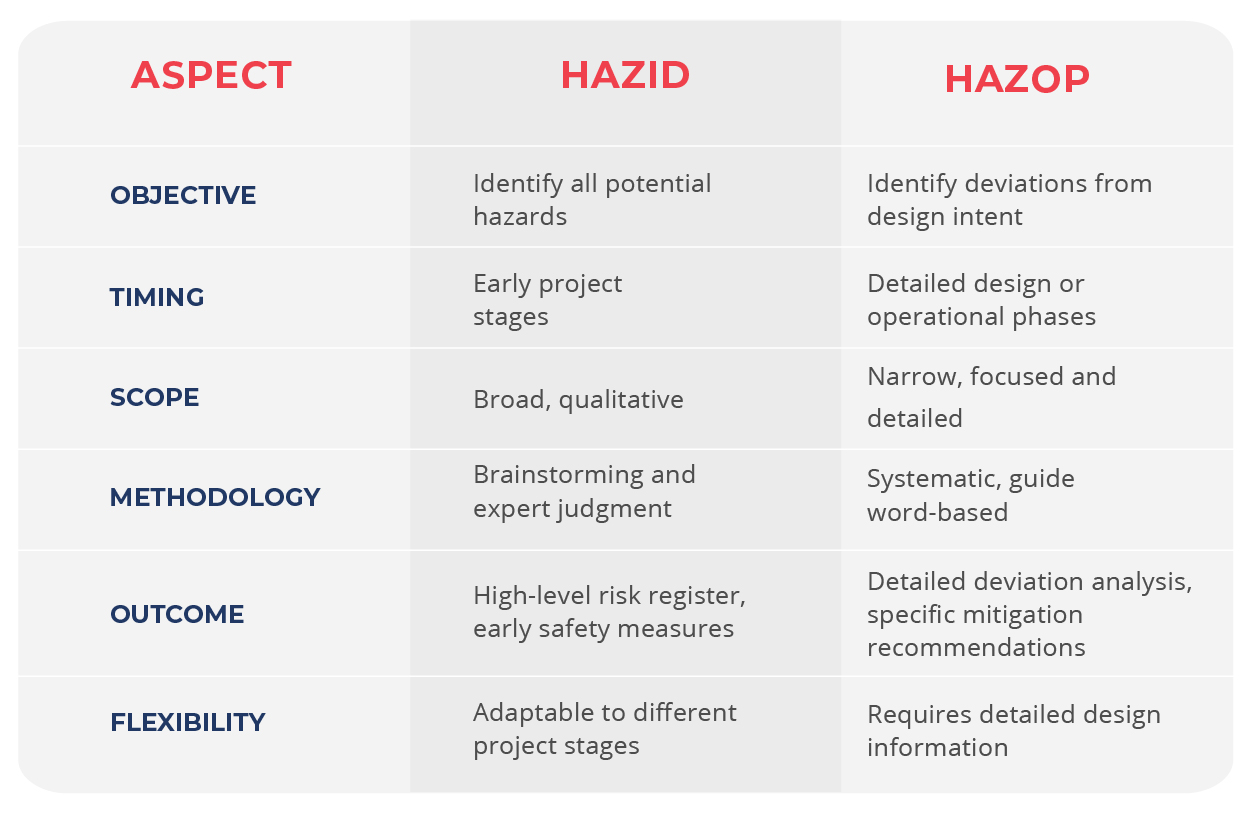What is HAZID?
HAZID, or Hazard Identification, is a preliminary risk assessment technique used to identify potential hazards in the early stages of a project. It is typically conducted during the conceptual design or feasibility study phase. The primary goal of HAZID is to identify all possible hazards that could impact the safety, environment, and operability of a facility. This early identification allows for the incorporation of safety measures into the project design before significant investments are made.
- Early Intervention: By identifying hazards early, design changes can be made before significant investments are committed. This proactive approach helps in embedding safety measures into the design, reducing the likelihood of costly modifications later in the project.
- Broad Coverage: HAZID covers a wide range of potential hazards, including those related to safety, environment, and operability. This broad scope ensures that all potential risks are considered, providing a comprehensive understanding of the project’s risk profile.
- Cost-Effective: Early identification of hazards can lead to cost savings by preventing expensive design modifications later in the project. By addressing hazards in the conceptual design phase, companies can avoid costly rework and delays during the later stages of the project.
- Qualitative Nature: HAZID does not provide a detailed analysis of the consequences or likelihood of identified hazards. The qualitative nature of HAZID means that it provides a high-level understanding of risks but lacks the detailed analysis needed to develop specific mitigation measures.
- Dependent on Expertise: The effectiveness of HAZID relies heavily on the experience and expertise of the team members. The quality of the hazard identification process depends on the knowledge and experience of the participants, making it essential to involve a multidisciplinary team with diverse expertise.
Key Features of HAZID
- Early Stage Analysis: Conducted at the beginning of a project to identify potential hazards early.
- Broad Scope: Covers a wide range of potential hazards, including safety, environmental, and operational risks.
- Qualitative Assessment: Focuses on identifying hazards rather than evaluating their consequences in detail.
What is HAZOP?

- Systematic Approach: The structured nature of HAZOP ensures that all possible deviations are considered. The use of guide words provides a systematic framework for identifying potential deviations, ensuring a comprehensive analysis of the process.
- Detailed Analysis: HAZOP provides a thorough analysis of potential consequences and helps in developing specific recommendations for mitigation. The detailed nature of HAZOP allows for the identification of specific hazards and the development of targeted mitigation measures.
- Improves Operability: By identifying operability issues, HAZOP helps ensure that the process runs smoothly and efficiently. The identification of operability issues can lead to improvements in process design, enhancing both safety and efficiency.
- Time-Consuming: The detailed and systematic nature of HAZOP makes it a time-consuming process. Conducting a thorough HAZOP study requires significant time and effort, making it a resource-intensive process.
- Requires Detailed Design: HAZOP cannot be effectively conducted without detailed design information, limiting its applicability in the early project stages. The need for detailed design information means that HAZOP is typically conducted during the detailed design phase or on operational processes.
- Resource Intensive: The need for a multidisciplinary team and detailed analysis makes HAZOP more resource-intensive compared to HAZID. Conducting a HAZOP study requires the involvement of a multidisciplinary team with in-depth knowledge of the process, making it a resource-intensive process.
Key Features of HAZOP
- Detailed Analysis: Conducted during the detailed design phase or on operational processes to ensure safe operation.
- Structured Approach: Uses guide words to systematically explore potential deviations from the design intent.
- Focus on Deviations: Identifies deviations that could lead to hazards or operability issues.
Applications
- Early Project Stages: Conducted during the conceptual design or feasibility study phase to identify potential hazards early.
- Feasibility Studies: Helps in evaluating the feasibility of a project by identifying potential safety, environmental, and operational risks.
- Conceptual Design Phase: Provides a broad understanding of risks, informing initial design decisions and safety measures.
- Detailed Design Phase: Conducted during the detailed design phase to identify deviations from the design intent and ensure safe operation.
- Operational Processes: Applied to existing processes to identify potential hazards and operability issues.
- Modification and Retrofit Projects: Used in projects involving modifications or retrofits to ensure that changes do not introduce new hazards.
Pros and Cons of HAZID and HAZOP

Case Study - Comparing HAZID and HAZOP for a Chemical Plant Expansion
Background
A chemical manufacturing company plans to expand its existing plant to increase production capacity. This expansion involves adding new reactors, storage tanks, and piping systems. The company is committed to maintaining high safety standards and decides to conduct both HAZID and HAZOP studies to identify and mitigate potential hazards associated with the expansion.
HAZID Study
Objective: Identify all potential hazards in the early stages of the project.
Approach: A multidisciplinary team including process engineers, safety experts, and environmental specialists conducts a HAZID workshop. The team uses checklists, industry standards, and past experiences to brainstorm potential hazards.
Findings:
- Chemical Release: Potential for toxic chemical releases during storage and handling.
- Fire and Explosion: Risks associated with flammable materials.
- Environmental Impact: Potential contamination of soil and water sources.
- Operational Hazards: Risks related to equipment failure and human error.
Outcome: The HAZID study provides a broad overview of potential hazards. The findings are documented in a high-level risk register, which informs the initial design and layout of the new facilities. Safety measures such as proper storage containment, fire suppression systems, and emergency response plans are recommended for inclusion in the project design. These are tracked using an Action Tracking System.
HAZOP Study
Objective: Identify deviations from the design intent that could lead to hazardous conditions or operability issues.
Approach: A detailed HAZOP study is conducted once the detailed design of the new facilities is completed. The same multidisciplinary team reviews the design using guide words (e.g., "more," "less," "none," "reverse") to systematically explore potential deviations.
Findings:
- Overpressure in Reactors: Identified the need for additional pressure relief valves to prevent reactor overpressure.
- Incorrect Mixing Ratios: Discovered potential for incorrect chemical mixing due to control system failures, recommending improved automation and alarm systems.
- Valve Failures: Identified the risk of valve failures leading to chemical spills, suggesting the use of fail-safe valves and regular maintenance checks.
- Flow Restrictions: Noted potential for flow restrictions in new piping, leading to process inefficiencies, and recommended redesigning the piping layout to ensure smooth flow.
Outcome: The HAZOP study provides a detailed analysis of specific process deviations and their potential consequences. Detailed recommendations for mitigation measures are developed, including design modifications, additional safety equipment, and improved operational procedures. These recommendations are recorded using an action tracking management system and implemented to ensure the safe and efficient operation of the expanded plant.
Comparison and Highlights

Key Differences Between HAZID & HAZOP Highlighted by the Case Study
- Stage of Application:
- HAZID is used early in the project to provide a broad overview of potential hazards, influencing initial design decisions.
- HAZOP is conducted later when detailed design information is available, focusing on specific deviations and their consequences.
- Level of Detail:
- HAZID offers a qualitative, high-level identification of hazards.
- HAZOP provides a detailed, structured analysis of potential deviations from the design intent.
- Outcome:
- HAZID results in a high-level risk register and general safety recommendations.
- HAZOP results in detailed recommendations for design modifications, additional safety equipment, and operational procedures.
